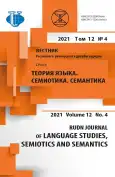Использование фонологического подхода при описании вокалической системы русского языка в условиях русско-испанского языкового контакта
- Авторы: Бондарева В.В.1
-
Учреждения:
- Российский университет дружбы народов
- Выпуск: Том 12, № 4 (2021)
- Страницы: 1260-1275
- Раздел: РУССКИЙ ЯЗЫК И МЕЖКУЛЬТУРНАЯ КОММУНИКАЦИЯ
- URL: https://journal-vniispk.ru/2313-2299/article/view/323345
- DOI: https://doi.org/10.22363/2313-2299-2021-12-4-1260-1275
- ID: 323345
Цитировать
Полный текст
Аннотация
Настоящая статья посвящена описанию вокалических систем разных языков с учетом функционального подхода, основываясь на объективной языковой действительности. На сегодняшний день традиционный подход, используемый учеными-исследователями, постепенно утрачивает способность выявлять эффективные модели фонетико-фонологической системы языка, что значительно отражается на продуктивности и результатах исследований. Стремительное развитие новых направлений науки, эволюция языковой системы и всех её подуровней говорит о необходимости корректировки традиционных принципов описания фонетико-фонологических систем разных языков и предъявляет особые требования к актуальности, продуктивности, адекватности и соответствию таких описаний объективной реальности. В статье приводится анализ системы гласных звуков с фонологической точки зрения - общая классификация гласных звуков через призму фонологической систематики смыслоразличительных оппозиций - с учётом артикуляционной базы языка и современной орфоэпической нормы, также учитываются их изменения в потоке речи, неразрывная связь с консонантизмом и просодической организацией слова. Данная система является более продуктивной и актуальна для решения задач современного языкознания. Апробация вокалической системы русского языка, полученной в рамках скорректированного подхода к описанию систем, проводится в условиях языкового контакта, поскольку проблемы языкового контакта взаимосвязаны с основными задачами теории языка в рамках сравнительно-исторического описания и сопоставления языков. Фонетическая интерференция вместе с иностранным акцентом являются следствием контакта родного и изучаемого языков. Именно фонетическая интерференция, являясь неотъемлемой частью языкового контакта, становится причиной нарушения звуковой стороны языка инофонов. Проанализировав описания вокалических систем испанского и русского языков, выполненных в рамках скорректированного функционального подхода, можно выделить основные черты испанского акцента при произношении русских гласных звуков, а анализ практического материала подтверждает все выделенные черты и демонстрирует высокую эффективность вышеописанного подхода. Результаты настоящей работы могут быть использованы в различных теоретических курсах, а также для создания систем автоматического синтеза и распознавания речи.
Об авторах
Вероника Валерьевна Бондарева
Российский университет дружбы народов
Автор, ответственный за переписку.
Email: bondareva-vv@rudn.ru
ассистент Института русского языка
117198, Российская Федерация, Москва, ул. Миклухо-Маклая, 6Список литературы
- Baudouin de Courtenay, J. (1963). Selected Works in General Linguistics. Volume 1. In 2 volumes. Moscow: Publishing House of the USSR Academy of Sciences. (In Russ.).
- Trubetzkoy, N.S. (2000). Principles of Phonology. Moscow: Aspect Press. (In Russ.).
- Jakobson, R. (1985). Selected Writings. Moscow. (In Russ.).
- Jakovlev, N.F. (1928). The Mathematical Formula of the Structure of the Alphabet (the Experience of the Practical Application of Linguistic Theory). In: Culture and Writing of the East. Vol. I. Moscow. pp. 41—64. (In Russ.).
- Zinder, L.R. (2007). General Phonetics. Moscow: Akademiya. (In Russ.).
- Bondarko, L.V. (2002) Triphthong. In: Linguistic Encyclopedic Dictionary. Moscow: Bol’shaya rossijskaya enciklopediya. (In Russ.).
- Reformatsky, A.A. (1970). From the history of domestic phonology. Moscow: Nauka. (In Russ.).
- Loginova, I.M. (1992). Description of the Phonetics of Russian as a Foreign Language (Vocalism and Stress). Monograph. Moscow: RUDN University Publ.(In Russ.).
- Bondarko, L.V. (2002). Vowels. In: Linguistic Encyclopedic Dictionary. Moscow: Bol’shaya rossijskaya enciklopediya. pp. 949—960. (In Russ.).
- Bondarko, L.V. (1965). Oscillographic Speech Analysis. Leningrad: Publishing House of Leningrad University. (In Russ.).
- Verbitskaya, L.A. (1965). Sound Units of Russian Speech and Their Relationship with Shades and Phonemes (Based on Russian Vowels) [dissertation]. Leningrad. (In Russ.).
- Verbitskaya, L.A. (1977). Modern Russian Literary Pronunciation (Theoretical Problems and Experimental Data) [dissertation]. Leningrad. (In Russ.).
- Likhtman, R.I. (2001). On the Issue of Pronunciation Styles of the Russian Literary Language. In: Collection of articles on the 80th anniversary of M.V. Panov. Moscow: Yaziki slavyanskoi kul’tury. pp. 197—210. (In Russ.).
- Bondarko, L.V. (1977). The sound system of the modern Russian language. Moscow: Prosveshchenie. (In Russ.).
- Trubetzkoy, N.S. (1990). Common Slavic Element in Russian Culture. In: Topics in the study of language, 3, 114—134. (In Russ.).
- Malakhova, M.G. (2018). The relevance of the study of the problem of sound interference in teaching Russian pronunciation to foreign students at the university. In: Actual Problems of Natural Sciences and Humanities, 3 (110), 56—59. (In Russ.).
- Weinreich, U. (1979). Languages in Contact: Findings and Problems. Kyiv: Vishcha shkola. (In Russ.).
- Budnik, E.A. & Loginova, I.M. (2012). Aspects of the Study of Sound Interference (Based on Russian-Portuguese Bilingualism). Monograph. Moscow: MESI. (In Russ.).
- Bekhtereva, N.P. (ed.) (1988). Mechanisms of Human Brain Activity. Part I. Human Neurophysiology. Leningrad: Nauka. (In Russ.).
- Polivanov, Е. (1931). La perception des sons d’une langue étrangère. In: Travaux du Cercle Linguistique de Prague, 4. Réunion phonologique internationale tenue à Prague (18—21 décembre 1930). Prague. pp. 79—96.
- Bernshtein, S.I. (1975). Questions of Phonetics and Teaching Pronunciation. In: Questions of Phonetics and Teaching Pronunciation. Moscow: Publishing House of Moscow University. pp. 5—49. (In Russ.).
- Galeeva, M.M. (1977). On Some Methods of Learning a Foreign Accent. In: Phonetic Research for Teaching Foreign Students Russian Pronunciation. Moscow: Patrice Lumumba Peoples’ Friendship University Publ. pp. 40—47. (In Russ.).
- Georgiou, G.P., Perfilieva, N.V., Denisenko, V.N. & Novospasskaya, N.V. (2020). Perceptual Realization of Greek Consonants by Russian Monolingual Speakers. Speech Communication, 125, 7—14. doi: 10.1016/J.SPECOM.2020.09.008
- Sawsan Askoul (2017). An acoustic analysis of the production of word-initial stop /p/ by late Arab bilinguals. Training, Language and Culture, 4 (1), 68—83.
- Quilis, A. & Fernández Joseph, A. (1996). Curso de fonética y fonología españolas. Madrid.
- Navarro Tomas, T. (1946). Escala de frecuencia de los fonemas españoles. In: Estudios de fonología española. Syracuse. pp. 15—30.
Дополнительные файлы









